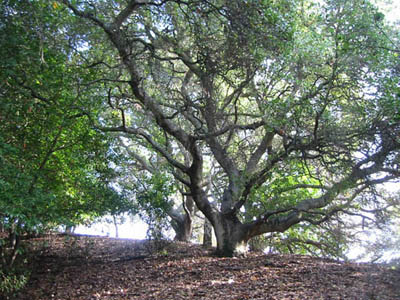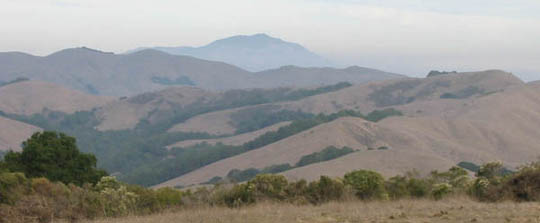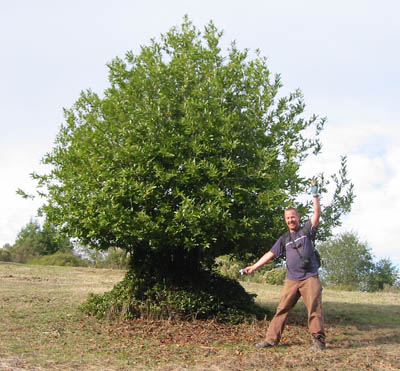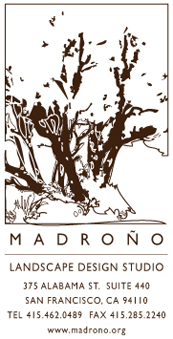 My comrade Pete Veilleux, native plant landscaper and bushwhacking enthusiast nonpareil, asked if I would like to join him on a hike to see a secret corner of Oakland. Not far from his house in the teeming East Bay 'hood where oaks no longer grow, steep mountains cleave the landscape and bulwark an ancient, fragrant forest of bay, oak, and madrone. So we climbed the ridge between Cull Canyon and the Upper San Leandro watershed, near Dinosaur Peak so-called for its rocky outcrops like the spiky plates of a stegosaurus, to seek out some of our favorite native plants and the hidden connections lurking in the everyday.
My comrade Pete Veilleux, native plant landscaper and bushwhacking enthusiast nonpareil, asked if I would like to join him on a hike to see a secret corner of Oakland. Not far from his house in the teeming East Bay 'hood where oaks no longer grow, steep mountains cleave the landscape and bulwark an ancient, fragrant forest of bay, oak, and madrone. So we climbed the ridge between Cull Canyon and the Upper San Leandro watershed, near Dinosaur Peak so-called for its rocky outcrops like the spiky plates of a stegosaurus, to seek out some of our favorite native plants and the hidden connections lurking in the everyday.
No trail marked our route; we parked on a friend's private property and walked for a spell up an old fire road, then plunged into the underbrush. Directions? We headed due southwest and uphill.
Veilleux waxed rhapsodic about the bay trees all around us: the manifold shapes of trunk, the lush color of the leaves when they catch the sun, and above all the scent, that wonderful smell. "I think Umbellularia californica is the most versatile and under-used California native plant in the landscaping trade," he said.
"Not in my yard," I replied. The mature bay reaches heights of 120 feet, and as wide. He allowed that regular pruning for size might be necessary. Mixed among the bays all around us, oaks and madrones whispered in the wind as if in awe of the bay's position as climax forest community, the ultimate dispatcher of other trees in the ecosystem.
"Look," said Veilleux, pointing. "It's a coffee fern! What a gorgeous Pellaea!"
I often see my own name written in native plants, but rarely so explicitly. Coffee fern (Pellaea andromedifolia) grows triangular fronds of delicate oval segments in a warm shade of green brushed with purple; we found them emerging from a vertical crevice in sheered-away rock like a spray of crystallized water. This plant also enjoys one of the most lovely and appropriate botanical names: the genus is Greek for "dusky," from the bluish-grey hue of the fronds, while the species name honors Andromeda, mythical beauty and princess of Ethiopia, the royal daughter chained to a cliff in sacrifice to a sea monster to appease angry gods. This long-creeping rhizome can act out a better Fay Wray than you'll find in the cinema, and can be used to great effect in the garden, e.g. between stones in a north-facing wall.
Suddenly, a thicket of poison oak blocked our way. At this time of year, the branches are bare of leaves, but Toxicodendron diversilobia still packs a wallop in its wood. This particular patch grew clear across the mountain face we were crossing, with no way around it.
"We just need to reach that ridge," said Veilleux. "It's not very far." Dubious at best, I thought. But he rolled down his sleeves, put on his gloves, and forged ahead.
I circled back downhill to look for a better approach, but there was none. No way to the top but through the toxic tangle. I did find a spot where the thicket looked thinner, but could see that the passage would still be severe.
I like to explore off-trail and to plumb the unknown; I do not like to become an itching ball of fire. Somewhere on the slope above me, I heard Veilleux thrashing through the poisonous branches and shouting "Almost there! Almost there!" Unable to throw my dermatology so casually to the wolves without good metaphoric support, I reminded myself that true character is built through adversity, true vision afforded only those who dare to transcend. And so I tucked my notebook and pen into my pack, pulled on my gloves, and looked for a very long minute -- then leaped.
I parted the thicket of menacing reddish-brown branches with a grimace and pushed through them for a minute or two, reaching the other side feeling fine despite what I considered my inadequate armor. Reunited, we made for the top of the ridge, where the tall trees gave way to a 10-foot micro-forest of coyote brush holding the perimeter of a mesa (recently cleared by bulldozers) with a commanding view of the East Bay hills sprawled between us and Mount Diablo like an odalisque.

We found what looked like an old Indian grinding stone beneath a gnarled, hoary oak on one side of the clearing, and stopped there for lunch. Absolute silence surrounded us, but for the cry of a hawk -- and looking out over so much natural Earth, I felt the shiver of my comparative youth beside these trees of centuries old, this landscape whose lifespan will be measured in millennia. Taking the view from among old oaks is good that way; it helps me change my units of thinking about time.
And yet mankind too has shaped this place: from the Indians renewing tired grasslands and oak woodlands by burning them to ranchers clearing woodland and brush for cattle; from developers chopping up parcels for a growing population to public utilities like EBMUD which owns and manages much of the Upper San Leandro watershed (in which we sat). Costs are high, both financial and spiritual, and the counties of Alameda and neighboring Contra Costa should be commended for the importance they have placed on the preservation of open space in this area.
 Finally we descended the other side of the mountain toward the crease at Redwood Rd., our destination. At some point we must have crossed the Chabot-to-Garin regional trail, which runs north and south along that ridge, but we never noticed it, nor met another soul. Instead we drank in the shapes and colors of the woods: giant bouqets of aromatic bay, sculpted cappuccino trunks of madrone, and the myriad contortions of coast live oak. Several specimens of coffeeberry (Rhamnus californica), that hardy evergreen shrub, gave me a wink from the edges of the chaparral. Various clearings showed signs of passing deer or cattle, and the stamp of the hand of man: we encountered a young bay pruned into an 8-foot Christmas tree, and another topiaried into a 15-foot mushroom. Swooping down a final series of lightly wooded slopes, we reached the road and my car parked in the Chabot staging area near a tree farm doing a brisk business in yultide conifers.
Finally we descended the other side of the mountain toward the crease at Redwood Rd., our destination. At some point we must have crossed the Chabot-to-Garin regional trail, which runs north and south along that ridge, but we never noticed it, nor met another soul. Instead we drank in the shapes and colors of the woods: giant bouqets of aromatic bay, sculpted cappuccino trunks of madrone, and the myriad contortions of coast live oak. Several specimens of coffeeberry (Rhamnus californica), that hardy evergreen shrub, gave me a wink from the edges of the chaparral. Various clearings showed signs of passing deer or cattle, and the stamp of the hand of man: we encountered a young bay pruned into an 8-foot Christmas tree, and another topiaried into a 15-foot mushroom. Swooping down a final series of lightly wooded slopes, we reached the road and my car parked in the Chabot staging area near a tree farm doing a brisk business in yultide conifers.
Who can say where nature ends and civilization begins? We might as easily seek the source of the longest river and the voice of the hidden waterfall. Deep connections are found at these intersections, where urban gives on to wild with all the subtle gradient of the old year passing into the new. Safeguard these connections wherever you can find them -- we protect our roots even as we reach for the sunlight, our future.
* * *
Geoffrey Coffey wrote this article from a bath of calamine lotion. He is the president of Madrono Landscape Design Studio, Inc. and a freelance writer for the San Francisco Chronicle.

